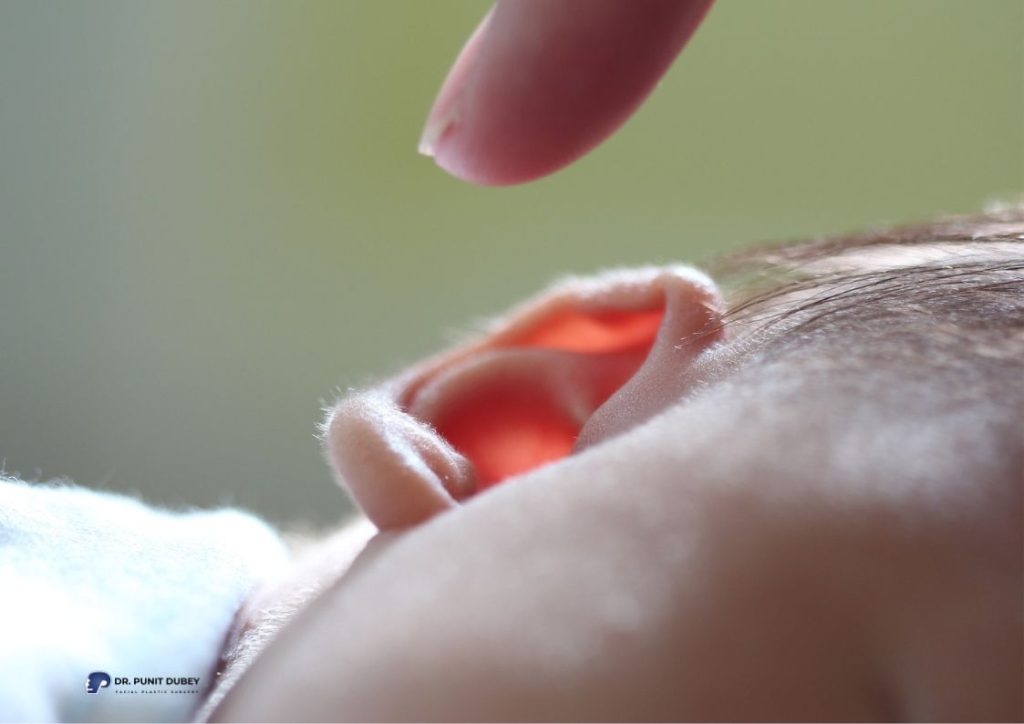
Infant Ear Molding in Delhi, India
Ear Molding
Table of Contents
What is Infant Ear Molding?
Infant ear molding, what is this whispered secret? It’s a non-surgical, gentle procedure, where soft, moldable ear cartilage of newborns is gently guided to adopt a natural, aesthetic shape. It’s like a potter’s gentle hands, lovingly shaping the clay, crafting perfection and beauty, allowing every child to wear their uniqueness with pride.
Have you ever wondered about the gentle art of reshaping a baby’s ear? Infant ear molding is a non-surgical procedure that artfully molds the cartilage of a newborn’s ear, guiding it to grow in a desired natural shape. It’s like a gentle hand, guiding the river to flow in the right direction.
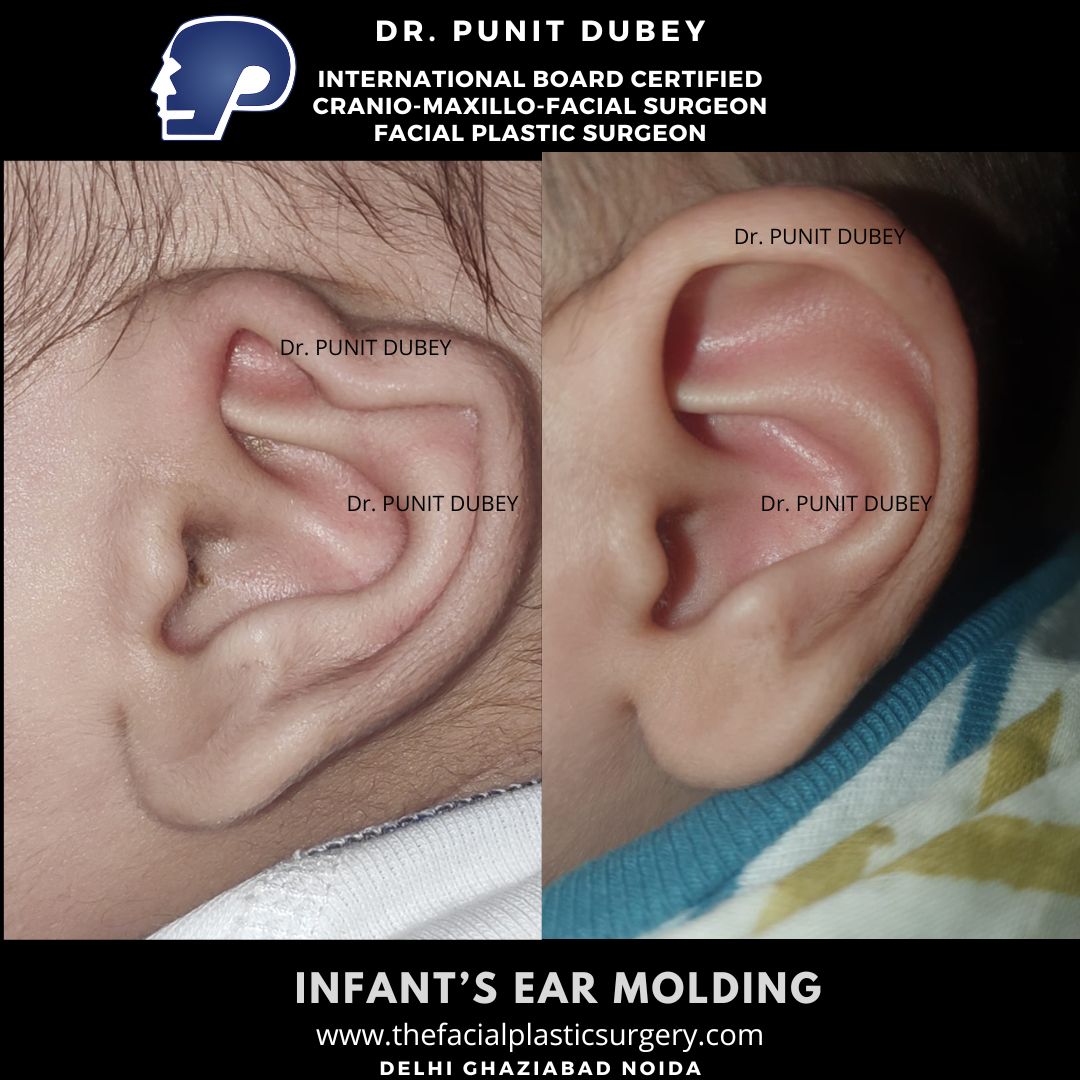
Understanding Infant Ear Deformities
In the landscape of pediatric health and well-being, understanding the various types of infant ear deformities is paramount for effective intervention and correction.
- Prominent Ear Deformity:
- Characteristics: The external ear projects noticeably from the side of the head.
- Implications: Beyond the aesthetic aspect, this prominence might lead to psychological impacts due to potential social attention and teasing as the child grows.
- Intervention Pathway: Non-surgical ear correction within the first weeks of life can effectively reshape the ear cartilage, promoting a more typical ear alignment and appearance.
- Lop Ear Deformity:
- Characteristics: The upper part of the ear tilts downward, leading to a unique ear shape.
- Implications: This form may present functional and aesthetic concerns.
- Intervention Pathway: Early intervention with specialized ear molding techniques can guide the ear to a more natural position and shape.
- Cup Ear Deformity:
- Characteristics: The ear exhibits a tight, inward curvature, presenting a reduced or constricted outer ear appearance.
- Implications: Beyond aesthetic concerns, this may impact the ear’s structure and function.
- Intervention Pathway: Tailored ear molding procedures can help in gently expanding and reshaping the ear cartilage, ensuring balanced ear development.
- Stahl’s Ear Deformity:
- Characteristics: An extra fold of cartilage is present, altering the natural contour of the ear.
- Implications: This additional fold can lead to an unusual ear shape, necessitating correction for aesthetic and structural harmony.
- Intervention Pathway: Expert ear molding can effectively reshape the cartilage, ensuring a natural, harmonious ear form.
- Constricted Ear Deformity:
- Characteristics: Parts of the ear appear reduced in size or are folded, leading to a smaller ear appearance.
- Implications: This constriction may lead to both aesthetic and functional concerns for the infant.
- Intervention Pathway: Comprehensive ear molding techniques can effectively address this deformity, promoting balanced ear growth and development.
- Cryptotia:
- Characteristics: The upper part of the ear is buried under the skin of the scalp, leading to partial visibility.
- Implications: This hidden aspect may require correction for optimal ear development and function.
- Intervention Pathway: Specialized ear molding interventions can help in unveiling the ear, promoting its natural shape and visibility.
Each deformity, with its unique characteristics and implications, underscores the significance of early, expert intervention. Tailored ear correction techniques emerge as a beacon of hope, offering effective, non-surgical pathways for ensuring the harmonious development and appearance of infant ears.
Ideal Candidates for Infant Ear Molding
In the realm of infant ear reshaping, identifying the ideal candidates is a crucial step towards successful and effective intervention.
- Age Factor:
- Insight: Infants within the first few weeks of life emerge as prime candidates. After age of 3 months, it becomes difficult to correct ear deformities.
- Reason: The ear cartilage retains exceptional pliability during this period, akin to soft clay ready for molding. This characteristic allows for the most effective and seamless reshaping, laying the foundation for optimal ear development and appearance.
- Ear Deformity Type:
- Insight: Infants presenting with any of the earlier mentioned ear deformities, such as prominent ear deformity, lop ear deformity, among others, stand as suitable candidates.
- Reason: The distinct types of ear deformities, each with their unique characteristics, can be effectively addressed through tailored ear molding interventions, ensuring specific, targeted correction and reshaping.
- Health Considerations:
- Insight: General good health of the infant is a prerequisite.
- Reason: Ensuring the infant’s overall well-being guarantees that the ear molding process unfolds smoothly, devoid of complications, promoting a healthy, balanced ear development journey.
In summary, the optimal candidates for non surgical ear correction are newborns within the first few weeks of life, presenting with specific ear deformities, and in good overall health. Early, tailored intervention during this window of opportunity ensures the most effective, enduring, and harmonious results in ear reshaping and development.
The Process of Infant Ear Molding in Delhi
If you’re searching for infant ear molding near me, Delhi emerges as a prime destination. Dr. Punit Dubey, a pioneer in this field, employs advanced “ear molding devices” to ensure precision and effectiveness in ear molding for babies.
The process of infant ear molding in Delhi is a harmonious blend of expertise, innovation, and gentle care, ensuring optimal results and infant comfort. Let’s embark on the journey, unfolding each step.
- Initial Consultation:
- Insight: The journey commences with a comprehensive initial consultation.
- Components: This stage encompasses a detailed examination of the infant’s ear, understanding the specific deformity, and discussing the potential pathway ahead.
- Objective: The aim is to craft a tailored intervention plan, ensuring alignment with the unique needs and ensuring the highest standards of care and effectiveness.
- Ear Molding Process:
- Insight: The heart of the journey, where the actual ear reshapping unfolds.
- Technique: Utilizing custom-made molds, the infant’s ears are gently guided and reshaped, addressing the specific deformity and promoting natural, harmonious growth.
- Duration: The process duration varies, generally spanning a few weeks, ensuring gradual, effective reshaping.
- Objective: The goal is to ensure the successful correction of the ear deformity, promoting optimal ear development and appearance, while ensuring the infant’s comfort and well-being.
- Post Ear Molding Recovery:
- Insight: A crucial phase, ensuring the consolidation of the molding results.
- Components: Monitoring the ears’ shape, ensuring stability, and providing any necessary additional support or intervention.
- Objective: To guarantee the enduring success of the ear molding, ensuring the ears retain their newly acquired shape and development trajectory.
In essence, the process of infant ear molding in Delhi is a meticulously orchestrated journey, integrating each phase – from initial consultation to the actual molding process, and post-molding recovery – with utmost precision, care, and expertise, ensuring the blossoming of optimal, harmonious ear development and appearance for every infant.
Treatment Steps for Using the EarWell Non-Invasive Correction System
The EarWell Non-Invasive Correction System is designed with components including an anterior cap, a posterior cradle, a retractor, and a conchal former.
Step 1: Preparation Carefully remove the hair around the ear to ensure a clear area. This step helps to avoid any skin damage and ensure the effective adherence of the cradle. Cleanse the skin with isopropyl alcohol to eliminate any oils, enhancing the cradle’s adhesion.
Step 2: Cradle and Retractor Application Affix the cradle to the ear and select a retractor of appropriate size. The retractor aids in pulling the helix, contributing to the ideal shaping of the auricle.
Step 3: Conchal Former and Anterior Cap Application Utilize the conchal former to correct the upper part of the auricle, helping to maintain the ear’s new shape. Apply the anterior cap to further secure the ear’s shape. An elastic headband may be used for additional external fixation if required.
Step 4: Personalized Adjustments Based on the specific ear deformity, necessary adjustments may be made. This could include trimming the retractor or the cradle to align with the unique ear shape, ensuring a tailored treatment approach and reducing potential complications.
This systematic approach with the EarWell Non-Invasive Correction System provides a structured pathway for effectively addressing infant ear deformities, ensuring optimal outcomes and minimized complications.
Risks and Considerations of Ear Molding
While the world of ear molding is adorned with numerous benefits, it is crucial to also turn the lens towards the potential risks and considerations, ensuring a well-rounded and informed perspective.
Potential Side Effects: Even though the ear molding process is non-invasive and gentle, potential side effects may still arise. It is important to acknowledge the possibility of minor discomfort or skin irritation during the procedure. Ensuring consistent and careful monitoring can help in promptly addressing and mitigating these concerns, ensuring the infant’s comfort and safety throughout the ear molding journey.
Importance of Expert Selection: The choice of a qualified and experienced practitioner stands as a cornerstone in the ear molding process. This decision holds significant implications for the success and safety of the procedure. Opting for a skilled professional guarantees adherence to the highest standards of care, precision, and effectiveness, ensuring not only the successful correction of the ear deformity but also safeguarding the infant’s overall well-being and health.
In the tapestry of non surgical ear correction, intertwining the threads of benefits with the strands of risks and considerations creates a balanced and holistic view. This comprehensive understanding is paramount in navigating the journey of ear molding, ensuring each step is taken with awareness, care, and the unwavering commitment to the infant’s health, comfort, and successful ear development.
Dr. Punit Dubey: A Pioneer in Infant Ear Molding in India
In the vast terrain of medical excellence, Dr. Punit Dubey emerges as a beacon of innovation, skill, and unwavering commitment to infant ear molding in India. His name resonates as a symbol of pioneering advancements and dedicated care in the field of ear molding.
First EarWell Physician in India: Dr. Punit Dubey holds the distinguished honor of being the first EarWell Physician in India, a testament to his groundbreaking work and expertise in this specialized domain. This accolade underscores his commitment to bringing global standards and advanced techniques to the Indian medical landscape, ensuring infants across the nation have access to world-class ear molding care.
Expertise and Innovation: Dr. Punit’s expertise transcends traditional boundaries, infusing innovative approaches and cutting-edge techniques in the ear molding process. His profound understanding and skill ensure each infant under his care receives tailored, effective, and gentle ear molding interventions, laying the foundation for optimal ear development and aesthetic harmony.
Commitment to Excellence: Dr. Dubey’s unwavering commitment to excellence echoes in every aspect of his practice. From the initial consultation to the meticulous execution of the ear molding procedure, his approach is infused with precision, compassion, and the dedicated pursuit of ensuring the best outcomes for every infant.
Contributions to the Field: Beyond his clinical practice, Dr. Punit Dubey’s contributions to the field of infant ear correction resonate in the corridors of medical education and knowledge dissemination. His efforts in advancing the understanding, techniques, and standards of ear molding contribute significantly to the ongoing growth and enhancement of this specialized field in India.
In the panorama of infant ear molding in India, Dr. Punit Dubey stands as a luminary, casting the light of his expertise, innovation, and commitment, guiding the path towards enhanced ear health, aesthetic balance, and holistic well-being for countless infants across the nation.
Benefits of Ear Molding
Ear molding offers a range of benefits, from correcting deformities to enhancing self-confidence and improving hearing. By considering this non-invasive and effective option, individuals can address ear concerns early on and prevent potential long-term issues. Remember, early intervention is key in achieving optimal results for ear molding procedures.
Correcting Deformities
- Ear molding can effectively correct deformities such as prominent ears, misshapen ears, and other structural abnormalities.
- By gently reshaping the cartilage in the ear, molding can create a more aesthetically pleasing appearance.
Preventing Permanent Damage
- Early intervention with ear molding can prevent the need for more invasive procedures later in life.
- By addressing ear deformities early on, you can avoid potential psychological and emotional distress in the future.
Improving Self-Confidence
- For individuals who are self-conscious about their ear appearance, ear reshaping can greatly improve self-confidence.
- Feeling more comfortable with their appearance can have a positive impact on overall mental well-being.
Enhancing Hearing
- In some cases, ear molding can improve hearing by adjusting the external ear structure.
- Properly shaped ears can help guide sound waves into the ear canal more effectively.
Non-Invasive and Painless
- Ear molding is a non-invasive procedure that does not require surgery or anesthesia.
- The process is painless and well-tolerated by patients, making it a safe option for ear correction.
Risks and Considerations
While the world of ear molding is adorned with numerous benefits, it is crucial to also turn the lens towards the potential risks and considerations, ensuring a well-rounded and informed perspective.
Potential Side Effects: Even though the ear reshaping process is non-invasive and gentle, potential side effects may still arise. It is important to acknowledge the possibility of minor discomfort or skin irritation during the procedure. Ensuring consistent and careful monitoring can help in promptly addressing and mitigating these concerns, ensuring the infant’s comfort and safety throughout the ear molding journey.
Importance of Expert Selection: The choice of a qualified and experienced practitioner stands as a cornerstone in the ear molding process. This decision holds significant implications for the success and safety of the procedure. Opting for a skilled professional guarantees adherence to the highest standards of care, precision, and effectiveness, ensuring not only the successful correction of the ear deformity but also safeguarding the infant’s overall well-being and health.
In the tapestry of ear molding, intertwining the threads of benefits with the strands of risks and considerations creates a balanced and holistic view. This comprehensive understanding is paramount in navigating the journey of ear molding, ensuring each step is taken with awareness, care, and the unwavering commitment to the infant’s health, comfort, and successful ear development.
Why Choose Delhi for Infant Ear Molding?
Infant Ear Molding Before and After: Real-life Transformations
In the panorama of infant ear correction, the before-and-after scenarios paint vibrant portraits of transformation, hope, and newfound harmony.
- Before the Procedure:
- Insight: Infants present with various ear deformities, casting shadows of potential future challenges and aesthetic concerns.
- Implication: The presence of these deformities underscores the significance of early, effective intervention, guiding the pathway towards balanced ear development and appearance.
- After the Procedure:
- Insight: Post-procedure, the ears exhibit a harmonious, natural shape, reflecting the successful correction of the deformities.
Implication: This transformation ensures the infant embarks on a future devoid of ear-related challenges, boosting their confidence and overall well-being.
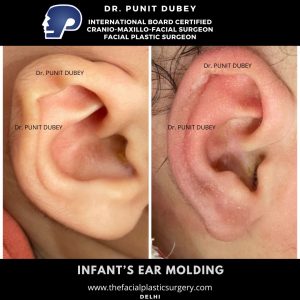
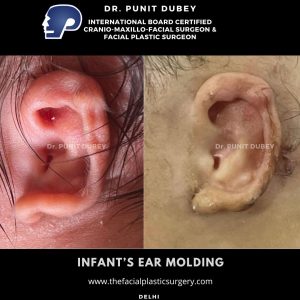
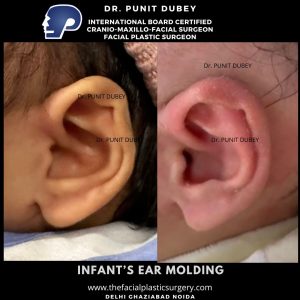
Infant Ear Molding Cost in India
Navigating the financial avenues of infant ear molding in India, one encounters a landscape of affordability intertwined with high-quality care standards.
- Investment in Future:
- The cost of ear molding is an investment in the child’s future well-being, appearance, and psychosocial development.
- This investment echoes long-term benefits, ensuring the child grows without the burden of ear deformities and associated challenges.
- Balanced Cost Structure:
- Insight: The cost structure in India is balanced, ensuring affordability while not compromising on the quality and standards of care.
- Implication: This balance guarantees that the procedure remains accessible to a wider population, ensuring more infants benefit from this life-enhancing intervention.
To provide a ballpark estimate of infant ear molding cost in Delhi, India.
- Earwell Ear Correction System: ₹27,888.
- Surgeon’s Charges per Ear: ₹40,000
Frequently Asked Questions About Infant Ear Molding (FAQs)
1. When is the Best Time to Start Ear Molding?
- The best time to start ear molding is within the first two weeks of the baby’s life.
- At this stage, the cartilage is still soft and pliable, making it easier to reshape.
- However, ear molding can be effective up to 6 weeks of age, although the results may vary.
2. Is Ear Molding Painful for the Baby?
- Ear molding is a non-invasive and painless procedure for the baby.
- The molds are designed to be comfortable and do not cause any discomfort to the baby.
- Some babies may fuss initially, but they quickly get used to wearing the molds.
3. How Long Does the Ear Molding Process Take?
- The duration of the ear molding process varies depending on the severity of the ear deformity.
- In general, the process can take anywhere from 2 to 6 weeks to achieve the desired results.
- Regular check-ups with the healthcare provider are essential to monitor progress and make adjustments if needed.
4. What Are the Success Rates of Ear Molding?
- The success rates of ear molding are high, especially when started early.
- Studies have shown that early intervention with ear molding can correct deformities in over 90% of cases.
- However, individual results may vary based on the severity of the deformity and the baby’s response to the treatment.
